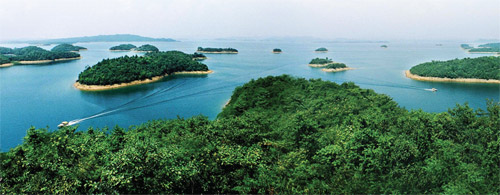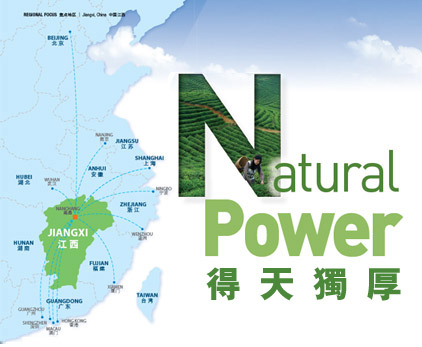 Abundant resources Abundant resourcesJiangxi is famous for its rich natural resources, which account for the success of the province in terms of economic and cultural developments. Water There are more than 2,400 rivers in Jiangxi Province, of which the Gan, Fu, Xin, Xiu and Rao rivers are among the largest. The water quality of more than 80 per cent of the rivers meets national second grade standards. Poyang Lake is the largest freshwater lake in the country, from which the annual run-off into the Yangtze River reaches 156.5 billion cubic metres, which is equivalent to the total run-off pouring into the sea from the Yellow, Hwai and Hai Rivers combined. Forests The forest coverage in Jiangxi is 63.1 per cent, the highest in the whole country. As a result, the air quality in cities across the province approaches the second grade of national standards. Minerals One hundred and seventy one different kinds of minerals have been discovered in Jiangxi, 111 of which have been verified as valuable mineral reserves. Twelve varieties including copper, tungsten, tantalum, niobium and uranium are the first to be found in China. Jiangxi also possesses the largest mines of copper, tantalum and niobium in Asia. The province holds commendations for “Green World Copper City” for Yingtan, “Asian Lithium City” for Yichun, “World Capital of Tungsten” and “Kingdom of Rare Earth”, both for South Jiangxi. Tourist attractions Jiangxi boasts Lushan Mountain, which is a World Culture Heritage Site. Sanqing Mountain, Longhu Mountain and Tortoise Peak have also been listed as World Natural Heritage Sites. There are also two world geology parks, namely Lushan and Longhu Mountains. Moreover, Jiangxi has 14 state-level scenic spots, 13 state-level nature conservations and 45 state-level forest parks. Agriculture Jiangxi is also rich in agricultural resources. Its unique climactic conditions promote the development of organic agriculture. High-quality, efficient eco-agricultural product processing industries with indigenous features come into their own here, including for grains, vegetables, fruit, livestock, poultry, aquatic products, tea and tea tree oil.  Highly efficient connections Jiangxi is well-connected domestically and internationally by a comprehensive and efficient transportation network, which comprises rail, road, air and sea. Railways Jiangxi is speeding up the construction of rapid transport access to Beijing, Shanghai, Shenzhen and Xiamen. In 2014 the Shanghai–Kunming railway is scheduled to begin operation, which will shorten the travel time from Nanchang to Shanghai to only three hours. High-speed EMU trains to Beijing will soon be operational via Shanghai–Kuming and Beijing–Guangzhou railways. In 2017, the Nanchang–Ji’an–Ganzhou railway will run, reaching Ganzhou in two hours and Shenzhen in five. In 2016, the Wuhan–Jiujiang railway will also be put into operation, making the travel time from Jiujiang to Wuhan only one hour. In 2013, the Jiangxi–Fujian railway launched, meaning a very fast journey of three and a half hours from Nanchang to Fuzhou and five and a half hours to Xiamen. Meanwhile, 11 rail-and-sea combined transportation routes, including two scheduled cargo railways from Shangrao (Yingtan) to Ningbo and from Ganzhou (Ji’an) to Xiamen, are already in operation. Expressways The total length of expressways in Jiangxi Province has reached more than 4,335 kilometres, enabling every county access to highways. The four-, six- and eight-hour green channels radiating from Nanchang to prefecture-level cities and to neighbouring capital cities are in constant use. The six-hour economic travel circle encompasses about 440 million people. Air There are six airports including Changbei International Airport in Nanchang, Huangjin Airport in Ganzhou, Luojia Airport in Jingdezhen, Jinggangshan Airport in Ji’an, Lushan Airport in Jiujiang and Mingyue Mountain Airport in Yichun. Sanqing Mountain Airport in Shangrao will become operational later this year. Regular flights from Jiangxi to Singapore, Thailand, Hong Kong and Taiwan are in operation, and unscheduled flights reach Korea. Sea Jiangxi serves as a gateway to main ports all over the world through the Nanchang International Container Dock and Jiujiang West Port, which can respectively berth 3,000-tonne and 10,000-tonne container ships. Three scheduled freight lines including Nanchang–Waigaoqiao in Shanghai, Jiujiang–Waigaoqiao, and Jiujiang–Yangshan Port in Shanghai are in service.  Key industries Strategic emerging industries have developed quickly in Jiangxi, which plays a facilitating and supporting role in the rapid economic development of the whole province. More scientific planning and adjustments have been implemented for strategic emerging industries. Among the strategic emerging industries are: aviation, advanced equipment manufacturing, new-generation information technology, lithium and electric vehicles, new energy, new materials, biology and new medicine, energy conservation and environmental protection, culture and creativity and green food.  Modern services industry Modern services industryJiangxi Province strives to build a strong services industry while it upgrades and develops, accelerating the rise of the province by focusing on key sectors such as finance, modern logistics, commerce and trade exhibitions, tourism, health and elderly care, e-commerce, culture and creativity and software and information. Its modern services clusters focus on urban complexes, commerce, trade and tourism, modern logistics parks, culture and creativity industrial bases, software and services outsourcing bases, and large-scale wholesale markets. Contact information Department of Commerce of Jiangxi Province 5 Shengfubeiyi Rd, Nanchang City, Jiangxi Province 330046, China Tel: 86-791-8624-6477 Fax: 86-791-8624-6450 Email: investment@jiangxi.gov.cn Web: www.jxdoftec.gov.cn |



